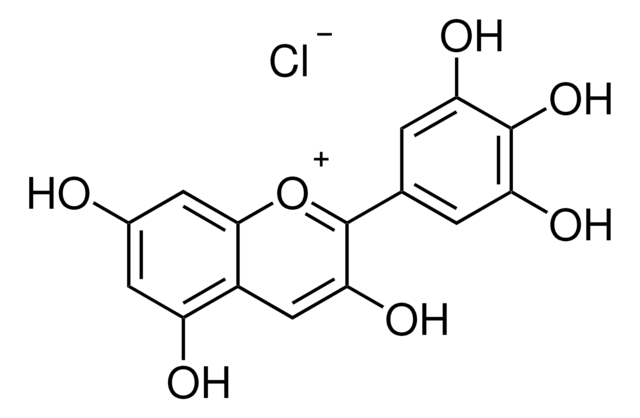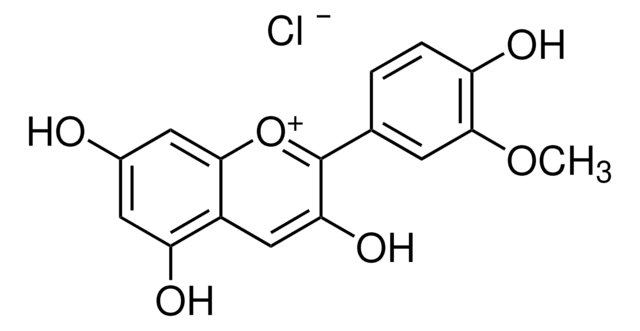Kluczowe dokumenty
Y0001061
Cyanidin chloride
European Pharmacopoeia (EP) Reference Standard
Synonim(y):
3,3′,4,5,7-Pentahydroxyflavylium chloride, Cyanidol chloride
Wybierz wielkość
664,00 zł
Wybierz wielkość
About This Item
664,00 zł
Polecane produkty
klasa czystości
pharmaceutical primary standard
rodzina API
anthocyanins, cyanidin chloride
producent / nazwa handlowa
EDQM
Zastosowanie
pharmaceutical (small molecule)
Format
neat
temp. przechowywania
2-8°C
ciąg SMILES
[Cl-].Oc1cc(O)c2cc(O)c([o+]c2c1)-c3ccc(O)c(O)c3
InChI
1S/C15H10O6.ClH/c16-8-4-11(18)9-6-13(20)15(21-14(9)5-8)7-1-2-10(17)12(19)3-7;/h1-6H,(H4-,16,17,18,19,20);1H
Klucz InChI
COAWNPJQKJEHPG-UHFFFAOYSA-N
Szukasz podobnych produktów? Odwiedź Przewodnik dotyczący porównywania produktów
1 of 4
Ta pozycja | 1151924 | PHR2695 | 94099 |
|---|---|---|---|
| grade pharmaceutical primary standard | grade pharmaceutical primary standard | grade certified reference material, pharmaceutical secondary standard | grade analytical standard |
| application(s) pharmaceutical (small molecule) | application(s) pharmaceutical (small molecule) | application(s) pharmaceutical small molecule | application(s) food and beverages |
| format neat | format neat | format - | format neat |
| API family anthocyanins, cyanidin chloride | API family cyanidin chloride, anthocyanins | API family anthocyanins, cyanidin chloride | API family - |
| storage temp. 2-8°C | storage temp. 2-8°C | storage temp. 2-8°C | storage temp. 2-8°C |
Opis ogólny
Zastosowanie
Działania biochem./fizjol.
Opakowanie
Inne uwagi
Kod klasy składowania
11 - Combustible Solids
Klasa zagrożenia wodnego (WGK)
WGK 3
Temperatura zapłonu (°F)
Not applicable
Temperatura zapłonu (°C)
Not applicable
Wybierz jedną z najnowszych wersji:
Certyfikaty analizy (CoA)
It looks like we've run into a problem, but you can still download Certificates of Analysis from our Dokumenty section.
Proszę o kontakt, jeśli potrzebna jest pomoc Obsługa Klienta
Masz już ten produkt?
Dokumenty związane z niedawno zakupionymi produktami zostały zamieszczone w Bibliotece dokumentów.
Klienci oglądali również te produkty
Active Filters
Nasz zespół naukowców ma doświadczenie we wszystkich obszarach badań, w tym w naukach przyrodniczych, materiałoznawstwie, syntezie chemicznej, chromatografii, analityce i wielu innych dziedzinach.
Skontaktuj się z zespołem ds. pomocy technicznej







